PDFelement-Powerful and Simple PDF Editor
Get started with the easiest way to manage PDFs with PDFelement!
An affidavit is a sworn written statement used in legal proceedings where the person making the statement declares its truth under oath or penalty of perjury. It serves as crucial evidence and provides firsthand information on facts or events within the affiant's knowledge. Affidavits are vital in court cases, contracts, immigration processes, and various legal matters.
Accurately filling out an affidavit is of utmost importance. Any inaccuracies or mistakes can undermine its credibility and potentially harm the case or legal matter associated with it. A properly completed affidavit ensures the reliability and validity of the information provided, strengthening its impact and supporting its purpose. Understanding the significance of correctly filling out an affidavit is essential for anyone involved in legal proceedings or requiring this document.

Part 1. Introducing PDFelement as a Powerful Tool
PDFelement is a powerful tool that simplifies the process of working with PDF documents. Its user-friendly interface and versatile features make it an ideal solution for filling out affidavits. With PDFelement, users can easily navigate and manipulate PDFs, making modifications and adding text, signatures, or checkboxes effortlessly.
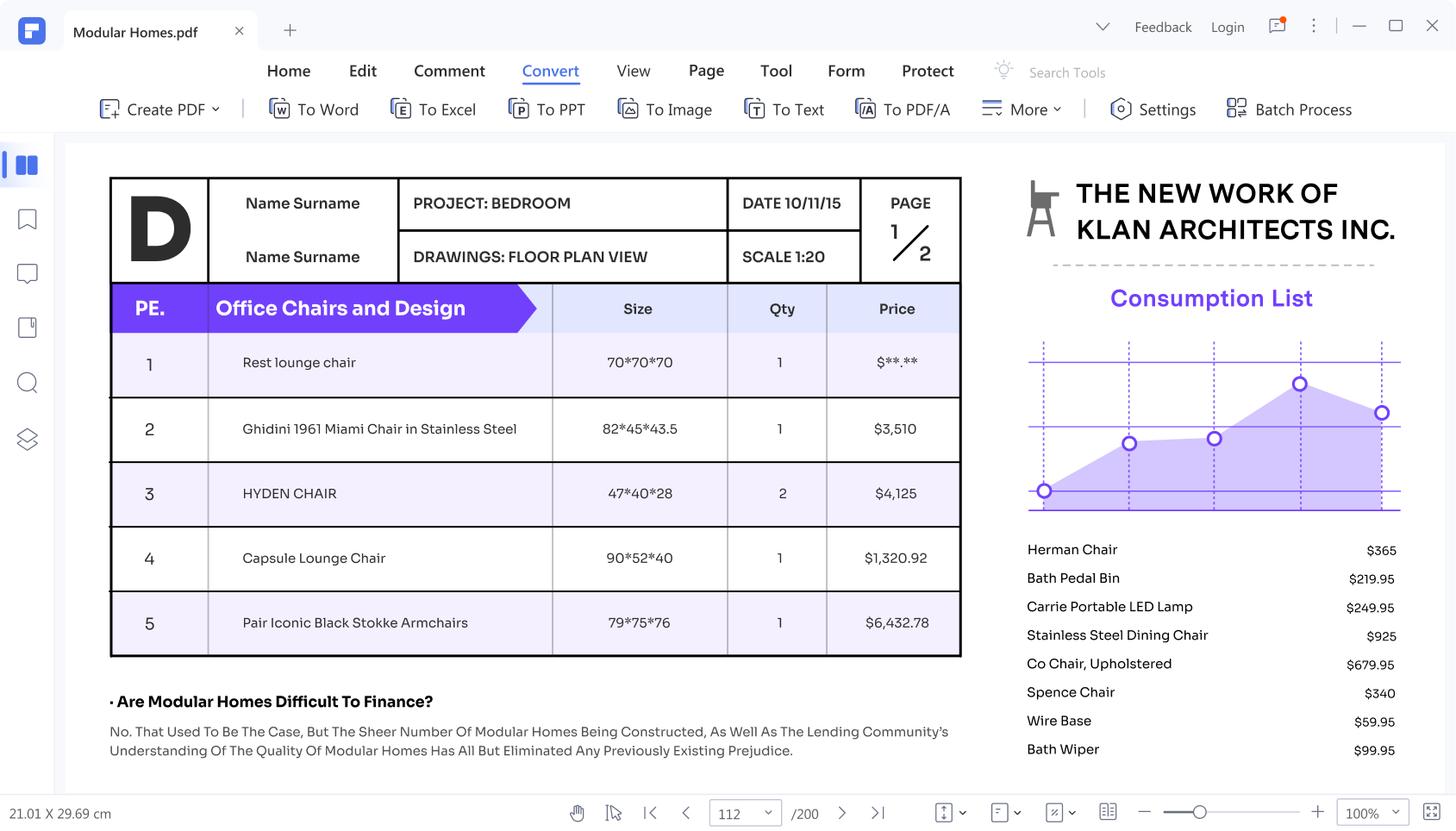
One notable feature of PDFelement is its extensive library of templates, including the I-134 Form Affidavit of Support template. This template specifically caters to individuals needing to fill out an affidavit for immigration purposes. Users can save time and ensure compliance with the required format and content for the I-134 form by utilizing the template.
PDFelement offers an intuitive and straightforward experience, allowing users to access various tools and functionalities. Its drag-and-drop interface enables seamless document manipulation, making it easy to rearrange pages, extract or merge files, and add annotations. The software also supports optical character recognition (OCR), enabling text extraction from scanned documents or images.
Additionally, PDFelement provides robust security features to safeguard sensitive information. Users can apply passwords, redact confidential details, and digitally sign affidavits to ensure authenticity and prevent unauthorized access.
Another advantage of PDFelement is its compatibility with various platforms, including Windows, Mac, iOS, and Android. This cross-platform accessibility allows users to work on affidavits from their preferred devices, enhancing convenience and productivity.
PDFelement stands out as a powerful and user-friendly tool for filling out affidavits. Its intuitive interface, extensive template library, and versatile features make it an indispensable resource for individuals needing to complete affidavits accurately and efficiently. Whether modifying PDF content, adding signatures, or utilizing the I-134 Form template, PDFelement provides a comprehensive solution for all affidavit-related needs.
Part 2. Filling Out an Affidavit With PDFelement
Filling out an affidavit with PDFelement is a straightforward process that ensures accuracy and efficiency. With its user-friendly interface and comprehensive tools, PDFelement simplifies completing affidavits, whether entering text, adding signatures, or customizing the document to meet specific requirements.
How To Fill Out a Small Estate Affidavit (Interactive Form)
Filling out a Small Estate Affidavit using an interactive form is a seamless process made possible with PDFelement. Interactive forms are designed to simplify entering information and completing legal documents. With PDFelement's intuitive interface, users can effortlessly navigate and fill out the Small Estate Affidavit Form.
Step 1 Launch PDFelement and open the Small Estate Affidavit Form.
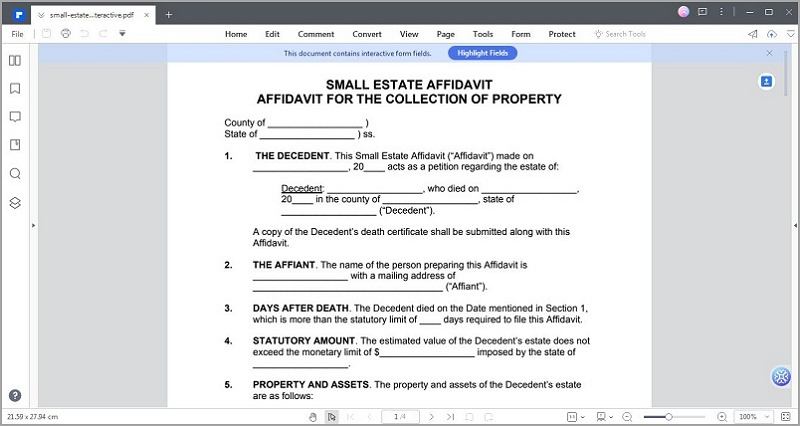
Step 2 Identify the blue-highlighted fields in the form.

Step 3 Input text or select options using the keyboard or dropdown menus.
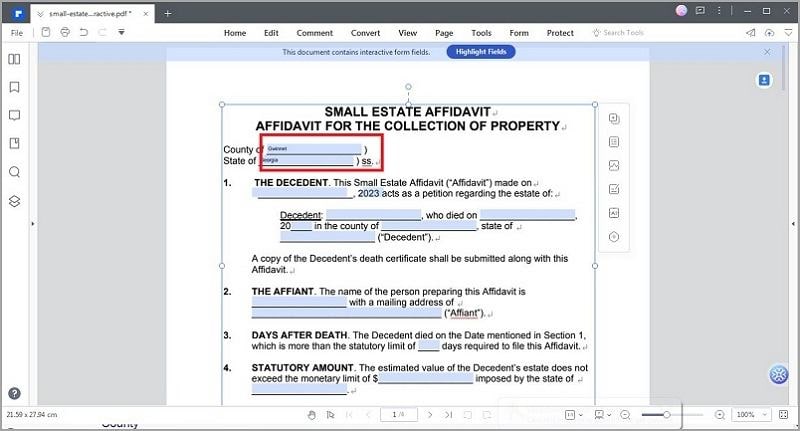
Step 4 Save the filled form by clicking "File" > "Save" or using the "Command + S" shortcut.

By utilizing PDFelement's interactive form features, individuals can easily navigate the Small Estate Affidavit Form, inputting the required information accurately and efficiently. PDFelement's user-friendly interface and step-by-step instructions streamline the process, ensuring users can confidently complete the form without complications. Whether providing personal details, asset information, or any other required fields, PDFelement empowers users to fill out the Small Estate Affidavit and meet the necessary legal obligations.
How To Fill Out a Small Estate Affidavit (Non-Interactive Form)
Filling out a Small Estate Affidavit using a non-interactive form can be made easier with PDFelement's "Recognize Form" feature. This feature allows users to convert non-interactive forms into fillable fields, simplifying entering information. By utilizing the "Small Estate Affidavit Form (Non-Interactive)" as an example, users can follow these step-by-step instructions to convert and fill out the form efficiently.
Step 1 Launch PDFelement and open the non-interactive form.
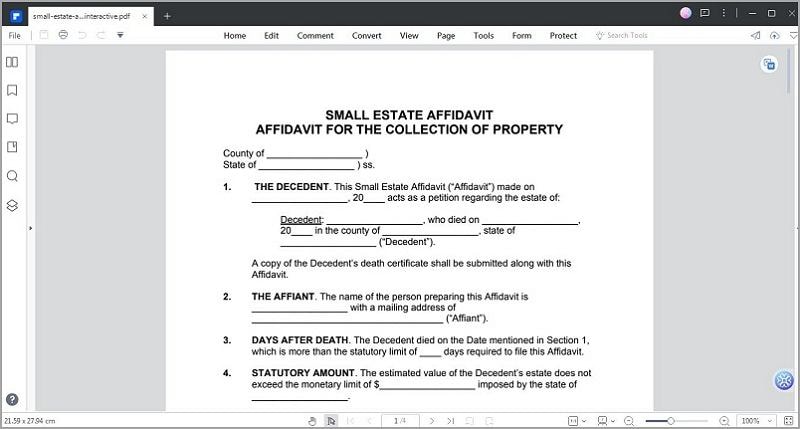
Step 2 Access the Form tab and click Recognize Form.
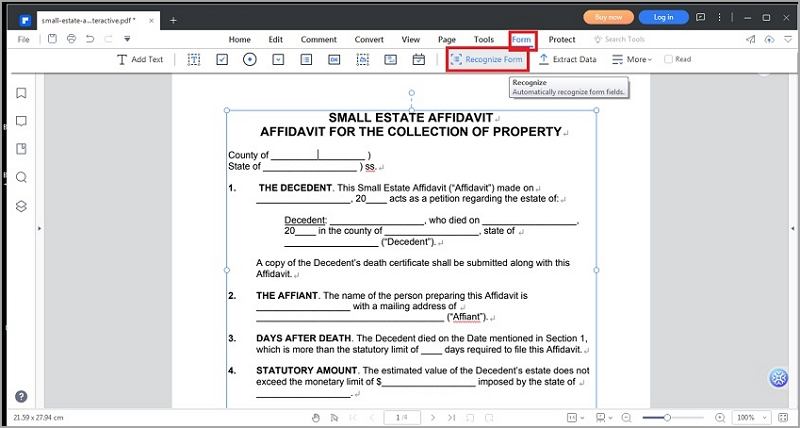
Step 3 Preview the converted form fields and fill in the required information.

PDFelement's "Recognize Form" feature simplifies working with non-interactive forms by converting them into fillable fields. This enables users to easily complete the Small Estate Affidavit by inputting the necessary information accurately and efficiently.
Creating an Interactive Form Manually
PDFelement empowers users to manually convert non-interactive forms into interactive ones, allowing for a more user-friendly and efficient form-filling experience. By following the instructions, individuals can seamlessly transform a non-interactive form into an interactive one. Let's explore the step-by-step process using an example.
Step 1 Launch PDFelement and open the non-interactive form.
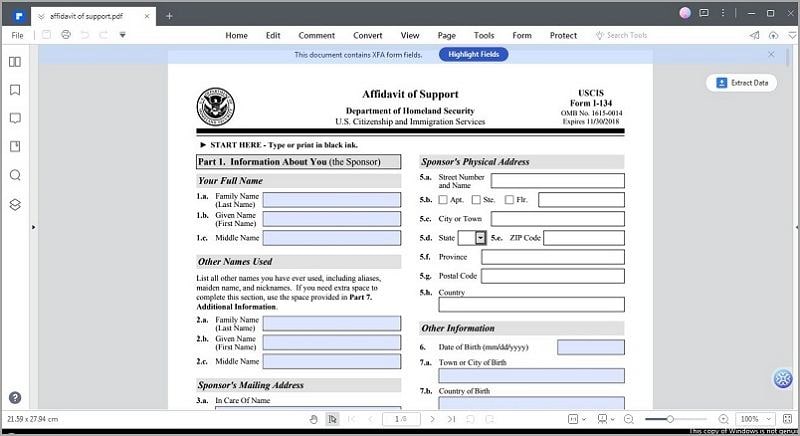
Step 2 Access the "Form" tab and select the desired form field tool.
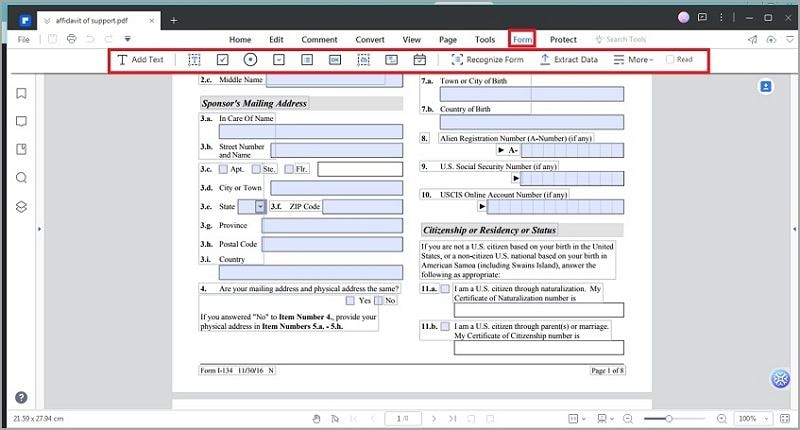
Step 3 Add form fields at appropriate locations on the PDF.
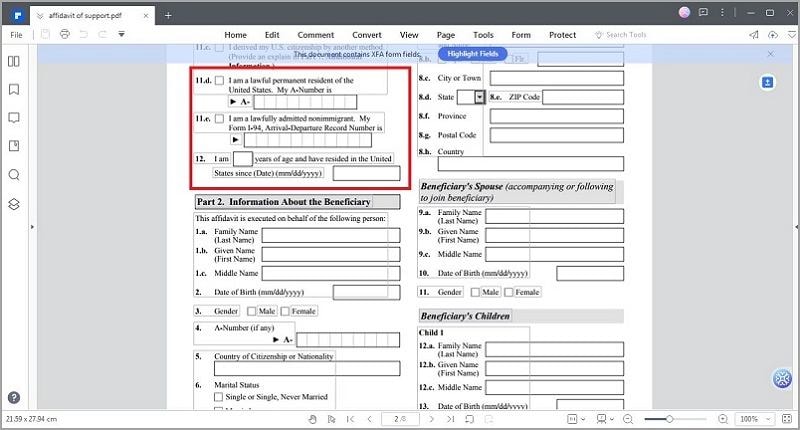
Step 4 Preview the form to ensure the correct positioning of the added fields.
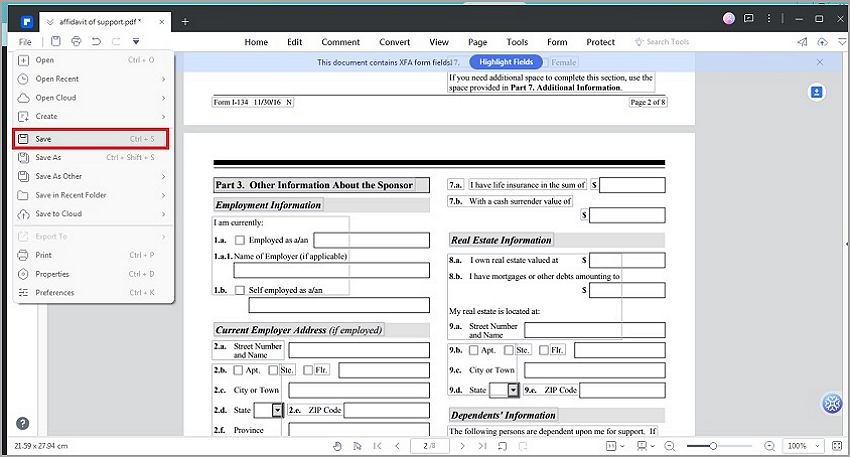
By utilizing PDFelement's manual conversion process, users can enhance non-interactive forms by making them interactive, thus improving the form-filling experience for both the creator and the end-user. The ability to manually add form fields provides flexibility and customization options, resulting in a more intuitive and user-friendly form for data entry.
Part 3. Common Mistakes To Avoid When Filling Out an Affidavit
While knowing what to do when filling out an affidavit is important, it's equally crucial to be aware of common mistakes to avoid. Here are some pitfalls to watch out for:
- Inaccurate or Incomplete Information: Ensure that all information is accurate and complete. Double-check names, dates, addresses, and any supporting documentation to avoid errors or omissions that could undermine the credibility of your affidavit.
- Ambiguous Language: Use unambiguous language to convey your statements effectively. Avoid vague or subjective terms that can lead to misinterpretation. Be precise and provide specific details that support your claims.
- Failing to Understand the Purpose: Fully grasp the purpose and intended use of the affidavit before filling it out. This will help you provide relevant and necessary information tailored to the document's specific legal matter or purpose.
- Ignoring Legal Requirements: Familiarize yourself with the legal requirements governing the specific type of affidavit you're completing. Failure to comply with legal guidelines can result in rejection or legal consequences. Pay attention to specific formatting, notarization, or jurisdictional requirements.
- Not Seeking Clarification or Legal Advice: If you encounter any uncertainties or have questions about the affidavit, seek clarification or consult a legal professional. They can provide valuable guidance and ensure that your affidavit meets legal standards.
- Rushing the Process: Take your time when filling out an affidavit. Rushing through the process can lead to mistakes or oversights. Carefully review each section, proofread your statements, and make necessary revisions before finalizing the document.
Part 4. Additional Tips for Filling Out an Affidavit Effectively
Filling out an affidavit effectively requires attention to detail and adherence to specific requirements. Here are some additional tips to ensure a successful affidavit submission:
Review The Affidavit Requirements
- Thoroughly read and understand the requirements set by the relevant authority or jurisdiction. Familiarize yourself with the specific format, content, and supporting documentation needed for the affidavit.
Gather Relevant Information and Documentation
- Collect all the necessary information and supporting documents before filling out the affidavit. This may include personal details, dates, addresses, and any relevant evidence or exhibits that support the statements made in the affidavit.
Use Clear and Concise Language
- When filling out the affidavit, use clear and concise language to convey your statements effectively. Avoid technical jargon or complex language that may confuse or obscure the intended meaning. Keep the language straightforward and easily understandable for readers.
Double-Check For Accuracy and Completeness
- Thoroughly review the affidavit once completed to ensure accuracy and completeness. Verify that all information provided is correct and that all necessary sections have been filled out accurately. Check for missing or inconsistent details that may raise questions or undermine the affidavit's credibility.
Seek Legal Advice if Needed
- If you have any doubts or concerns about filling out the affidavit, consider seeking legal advice from an attorney or legal professional. They can provide guidance specific to your situation, ensuring that your affidavit meets the necessary legal requirements and addresses potential legal implications.
Understand the Consequences of False Statements
- Be aware of the serious consequences of making false statements in an affidavit. Affidavits are considered legal documents and are typically signed under penalty of perjury. Knowingly providing false information or making misleading statements can result in legal consequences, including perjury charges.
Sign and Notarize the Affidavit
- Ensure you sign the affidavit in the designated space and follow any additional requirements for signature and notarization. Depending on the jurisdiction or specific circumstances, you may need to have your affidavit notarized by a licensed notary public to confirm its authenticity and legal validity.
By following these additional tips, you can enhance the effectiveness and credibility of your affidavit. Paying attention to the requirements, gathering relevant information, using clear language, verifying the accuracy, seeking legal advice, understanding the consequences of false statements, and properly signing/notarizing the affidavit are essential to ensure a successful and legally sound affidavit submission.
Conclusion
Filling out an affidavit effectively requires careful attention to detail and adherence to specific requirements. You can ensure a successful and legally sound submission by reviewing the affidavit guidelines, gathering the necessary information, using clear language, double-checking for accuracy, seeking legal advice, and correctly signing/notarizing the affidavit. These tips will help you confidently navigate the process and strengthen your affidavit's credibility.


